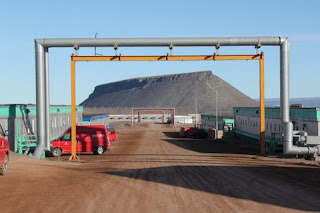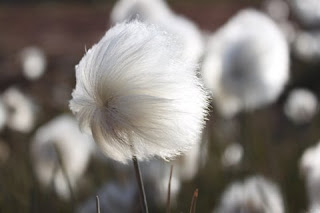Ok, the People! I’m here helping out a collaboration that includes Ph.D.s : Ron Sletten (UW, geochemistry), Birgit H. (U Alaska, geochem.), Karen Junge (Principal Investigator, UW, microbiology) and Brent (U. Louisiana, microbiology). Right now, there are five of us here: Lu and I (grads, under Ron), Laura (undergrad, under Karen), Kyla (grad, under Birgit) and Markus (post-doc, under Brent). Kyla and Markus both have research goals dependent on the sampling and research being conducted. Laura, Lu and I are here to help, contribute our knowledge and get some field experience. It’s certainly a fun group to hike with during the day and hang out with in the evenings!
Aside from sampling, and typical sample processing, I’ve contributed by getting a high purity water filter up and running. The water purifier makes ridiculously clean water for use in the iron analysis chemistry, etc. It connects directly to the water faucet and pumps the water through a series of purifiers. When the purifier tank is full, however, the pump shuts off and pressure builds in the tube…so much so that the tube exploded, or, if caught in time, it looks like a huge balloon and sprays out from the hose clamped connections…not so ideal. So I made an overflow outlet in the main water supply tube with a pipette tip and additional tubing. This eliminates the pressure issue. WIN.
I’m also helping trouble shoot the iron analyses and managed to make an anerobic (no Oxygen) Fe(II) standard. Turns out, three years as a lab rat makes you useful to field monkeys J
The research! The goal of the research is to look for a link between cryophiles (cold loving microbes!) and chemical erosion under glaciers and the ice sheet. Microbes are ubiquitous in the environment, and are even found in ice. The idea follows that microbes living in and beneath the ice sheet may be promoting, and perhaps speeding-up, chemical erosion rates. i.e. dissolve rock! Microbes can do this in a couple ways: 1)by metabolic processes where they actually “eat” rocks for an energy source (aka chemo-litho-autotrophs); 2.) by releasing organic compounds that break down the rock; or 3.) perhaps, simply by their physical presence, that is, their surfaces interact with dissolved ions which may affect the rate at which minerals are chemically eroded (don’t think too hard about it, I skipped a lot of steps/explanations in this one, I’d be happy to tell you more if you want it!)
Why do we Care!? The goal is to learn more about how microbes can affect the transport of major ions and elements in cold regions. Major ions such as iron act a nutrients in the oceans while others such as calcium plays a part in limestone formation and CO2 cycles.
So, we need to find and sample sub-glacial water flow and compare it to surface melt water. In both of these sources they will analyze the microbial communities and water chemistry and try to determine links between the two. The surface melt water part is easy… too easy…its sunny 24 hours a day, resulting in extensive snow and ice melt. North river runs parallel to the ice sheet, and is flowing with such force that you can hear boulders trundling down through the rapids (class 2-3?). We have no reason to believe that any of the smaller streams issuing from the ice sheet are true sub-glacial flow. Hopefully colder weather in late august will reduce the melting and reveal some promising sub-glacial springs.
The field! I’ve been in the field every day. We have two weekly sample sites and some additional locations that we monitor every other week.
Vortec : 2x weekly sampling. We take a side road that “ends” at a military radio/satellite/who-knows-what station that we call “the bowling pin”… unless we are lazy, then we keep driving over the glacial till and tundra until it gets too bumpy and rutted. The hike, even from the bowling pin, is only about 30 minutes, but the rocks, ice and terrain are remarkable. The glacial till challenges every step with loose ankle-breaker sized rocks. After only a couple weeks here you begin to appreciate the size of rocks and what it means for your footing. Smaller or bigger rocks, no problem, but the fist to head sized ones, watch out! 90% of the terrain here is covered by the “ankle roll” range, and it really slows things down! As you approach the ice cliffs a large sandstone formation appears. Wide, perfectly preserved ripple marks run along dislodged slabs of copper colored sandstone. Symmetrical ridges on the ripple marks tell us that a large lake once shaped sandy shores in this part of Greenland. The sandstone lies atop a black shale deposit that is flaking away along the edges of a 20 ft deep drainage cut. We hike down into the drainage and towards the valley cut by the North River. North river is bound by the terminal moraine of the Greenland ice sheet, glacial till and black shale cliffs. Towering ice cliffs loom over our sampling site. Blue and brown layers within the ice form elaborate horizontal banding patterns while waterfalls drain from the top of the ice sheet, cutting bright blue channels or leaving vertical mud deposits. Rocks fall from the ice cliffs every day. We see them bounce down channels and slide off ledges crashing into the river below.
There is a glacial outflow about 500 feet north of where we sample… but with the combination of shale and ice cliffs and, fast moving, deep water, we cannot get to it. Today (Aug 5th) Markus and I went on a scouting hike, with an end goal of sampling the outflow channel visible from Vortec. It took us about 5 hours, round trip, to reach the outflow and sample it. We had to hike north from where we parked our F-350 (oh, and I get to drive and F-350 a lot, its fun when you aren’t paying for the gas…or thinking about the pollution it produces) to find a suitable place to cross the river. I have a bit of a mass problem when it comes to crossing fast moving water, I just don’t have enough of it, so Markus gave me a hand. We crossed the river up-stream of several large inputs.
We work along an ice front that seems to be a lobe of the ice sheet itself. This might be in contrast to a glacier, which extends from the ice sheet and weaves its way down a valley or between mountains. (glaciologists, correct me if I’m wrong in this distinction!) Fingers of ice form sloping ridge lines that reach out from the ice sheet lobe. In some places these ice ridges are cut by the river resulting in ice cliffs. Others have their own melt water tributaries that dump water into the North River, drastically increasing the flow downstream. We crossed one of these tributaries by traversing the ice around the mouth of the outlet. There is a fair amount of gravel embedded in the ice along with a crusty layer of snow and slush that supplies some grip for boot treads. We crossed sans crampons. We continued along the terminal moraine, crossing many small melt tributaries. To get to the outflow just north of Vortec we had to cross one last ice ridge. We climbed to the top in our boots…a bit tricky as I found a very wind scoured patch that was solid, slippery ice, if you fell you would slide about 20ft to the bottom, not the end of the world, but not a nice prospect. At the top we found that the ridge was not so symmetrical and dropped off rather sharply on the other side…we aren’t ice climbers :)… So we went back down the way we came, donned the waders and waded along the small ice cliff. We finally reached the outlet we had set out for and set up shop on the rocky shore. I choose to toss my gear below the main drainage path since there were rocks, some the size of baseballs and footballs, falling from the ice cliffs just upstream of the main drainage. As I was sitting there filtering out the samples, Markus noticed a new, thick flow of muddy water issuing from the top of the ice sheet and running down the dirt encrusted ice drainage. OK, not a good place to filter! We quickly moved our equipment away from the drainage path… and into the rock fall path, great. Mental note, NEXT TIME, PACK A HELMET! Duh.
Sometimes, lakes and pools on the ice sheet can suddenly drain. We have to watch out for these events in case we are in the river or near the meltwater outflows. We may have witnessed a small event when the muddy water started running down the drainage. We got out of that place a quickly as possible, happy to be away from the falling rocks and water flows. The hike back included a couple tricky river crossings but, fortunately, nothing too exciting.
There is so much going on here it’s hard to keep up with posting! I find I am not tired until I am exhausted! Next round I’ll fill in details on the other sampling sites and our camping trip: eating homemade quiche and sleeping on the beach, in a spectacular fjord where three tidal glaciers dump ice bergs into the icy waters. Rad.
Also, thanks KP for posting info about the flora photos and correcting my usage of Moulin! I guess that sample location is just an ice river…we’ve dreamed of epic dry-suit tubing down those snow/ice fields :)

































